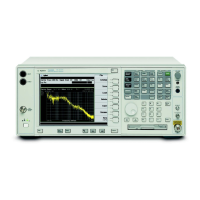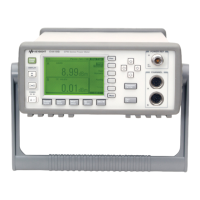76 Chapter 2
Instrument Functions: A - L
BW/Avg
Instrument Functions: A - L
2.3.5.2 Log-Pwr Avg (Video)
Selects the logarithmic (decibel) scale for all filtering and averaging processes. This scale is
sometimes call “Video” because it is the most common display and analysis scale for the
video signal within a spectrum analyzer. This scale is excellent for finding CW signals near
noise, but its response to noise-like signals is 2.506 dB lower than the average power of
those noise signals. This is compensated for in the Marker Noise function. When this type
of averaging is selected, LgAv appears on the left side of the display.
The equation for trace averaging on the log-pwr scale is shown below, where N is the
number of averages accumulated. (In continuous sweep mode, once N has reached the
Average Number, N stays at that value, providing a running average.)
Assumes all values in decibel scale.
Key Path:
BW/Avg, Avg/VBW Type
or Auto Couple, Avg/VBW Type
Remote Command:
See “Avg/VBW Type” on page 74.
Example: AVER:TYPE LOG
2.3.5.3 Pwr Avg (RMS)
In this average type, all filtering and averaging processes work on the power (the square of
the magnitude) of the signal, instead of its log or envelope voltage. This scale is best for
measuring the true time power of complex signals. This scale is sometimes called RMS
because the resulting voltage is proportional to the square root of the mean of the square of
the voltage. When this type of averaging is selected, PAvg appears on the left side of the
display.
In the equation for averaging on this scale (below), N is the number of averages
accumulated. (In continuous sweep mode, once N has reached the Average Number, N
stays at that value.)
Assumes all values in dB.
New avg
N 1–()Oldavg Newdata+
N
-------------------------------------------------------------------=
New Avg 10
N1–()10×
Old Avg
10
--------------------
10
New data
10
----------------------
+
N
------------------------------------------------------------------------------
log×=

